The Supermicro X10DAC is a new workstation motherboard targeted at dual Intel Haswell-EP deployments with significant integrated storage needs.. Using our model name decoder ring we see the “X10” series (socket LGA2011-3 generation), “D” dual socket, with “A”udio. There are several other motherboards in the X10DA series, including the X10DAi we reviewed recently. One of the key features of the X10DAC is an onboard LSI / Avago SAS3008 HBA. Longtime STH readers will recognize that Supermicro motherboards with integrated components are often a more cost-effective way to add features to a server or workstation. The X10DAC is no exception as it has a street price premium of under $100 over the X10DAi but effectively includes a $250-300 SAS controller.
Test Configuration
We used a fairly typical DP workstation setup for this type of platform and what we have used previously in our Intel Xeon E5-2600 V3 coverage.
- CPU: 2x Intel Xeon E5-2690 V3
- Motherboard: Supermicro X10DAC
- Memory: 8x SK. Hynix 16GB DDR4 2133MHz ECC RDIMMs
- SSD: 2x Samsung 840 Pro 256GB 4x Crucial M500 240GB, 3x SanDisk CloudSpeed Ultra 800GB SATA, 3x Intel S3700 100GB
- Video Cards: NVIDIA K4000, Zotac GT610
- Operating Systems: Ubuntu 14.04 LTS, Windows Server 2012 R2, VMware ESXi 5.5, CentOS 6.5
The test platform was rather expansive due to the enhanced SSD capacity of the motherboard.
Supermicro X10DAC Overview
The Supermicro X10DAC is an EATX motherboard measuring a class standard 13″ x 12″. This EATX form factor can be fit into everything from 4U style cases to smaller mid towers such as the Supermicro SC732i.
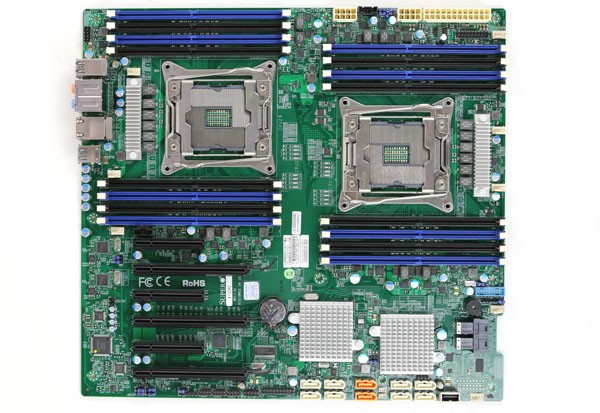
When dealing with smaller chassis, one does need to ensure they fit an EATX motherboard and large enough coolers. We are using the Supermicro SNK-P0050AP4 which is our standard cooler for thermal testing all LGA2011 motherboards. This solution will fit in most smaller 4U sized enclosures.
Looking at the CPU and memory layout, one can see that the 16 DIMM slots and 2 CPU sockets are aligned for front-to-back cooling. Supermicro’s workstation chassis and most rackmount chassis are built with this layout as it is very efficient.
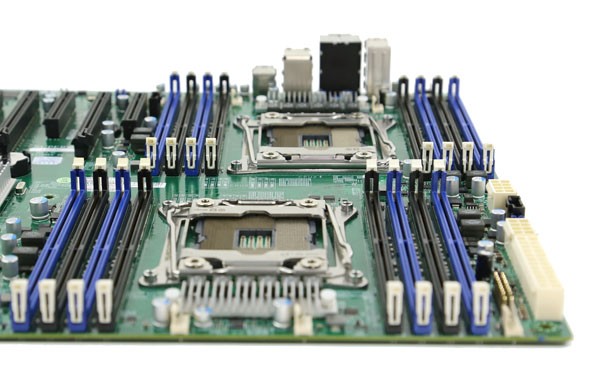
One great feature with the X10DAC is that the heatsink mounting pattern is the square ILM rather than the narrow ILM found on many similar motherboards. This means that one has a wide range of thermal solutions available for the motherboard. Many prosumer workstation motherboards sacrifice using either narrow ILM heatsink mounting or only 4 DIMMs/ CPU (8 total) designs. The X10DAC has square mounting and can accept up to 16x DDR4 RDIMMs for 512GB ECC RDIMM capacity or 1TB of LRDIMM RAM.
Both the CPU and ATX power connectors are along the top side of the motherboard which works very well with cases that follow traditional server/ workstation layouts. The warning stickers on the 8-pin CPU power connectors warn users that they should be utilized for high-power applications. We strongly suggest using both and a compatible power supply for dual socket configurations to ensure stability.
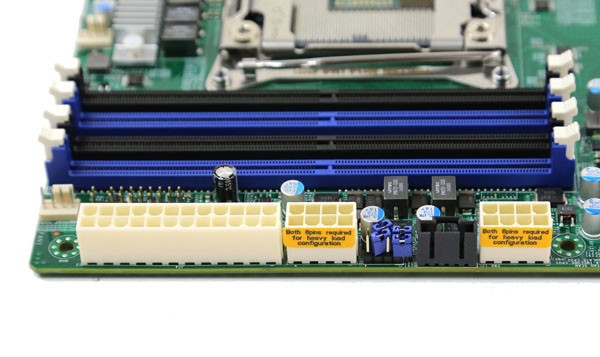
In terms of PCIe expansion, one can see a solid set of slots. There are three PCIe 3.0 x16 slots for GPUs or MICs. These slots are spaced for double-width coolers which are prevalent on higher powered cards. There are two PCIe 3.0 x8 slots which are excellent for HBAs and other cards. Finally there is a PCIe x8 slot that runs at PCIe 2.0 x4 electrical. This provides six usable slots onboard which is excellent given that there is already a 12gbps SAS HBA onboard. The X10DAC also has a header for a PCIe based Thunderbolt add on card.
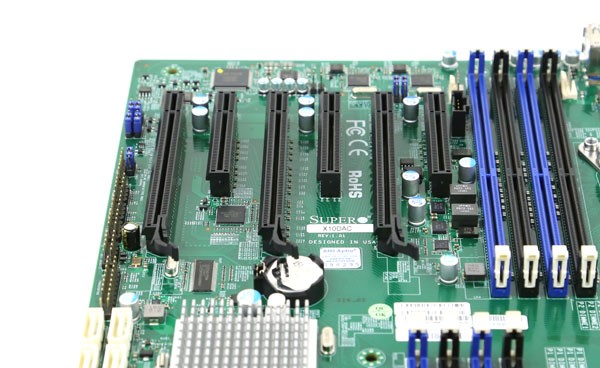
The X10DAC utilizes an onboard Intel C612 PCH, and exposes the ten SATA III ports associated with the PCH. Two of these SATA III ports(in gold) have associated SATADOM power connectors so SATADOM modules can be used with them. The net impact is that the motherboard can handle a high quantity of SATA SSD or hard drive storage locally. Of course, with the X10DAC this is only part of the storage picture.
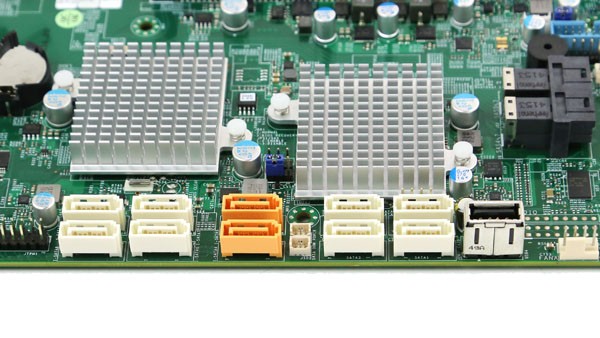
Probably the biggest standout feature of the Supermicro X10DAC is the onboard LSI / Avago SAS 3008 controller. The SAS3008 is a cacheless HBA that can be used either in IT mode (HBA) or IR mode (RAID 0, 1, 10). The SAS 3008 is a very fast controller that features eight 12gbps SAS3 ports. As we have seen already with some of our SAS3 benchmarks such as the Toshiba PX02SMU080 800GB drive we benchmarked recently, it would not be hard to populate this controller with eight drives each capable of over 1GB/s transfer speeds. When this controller is combined with the ten SATA 3 ports, one has up to 18 storage ports available using onboard controllers.
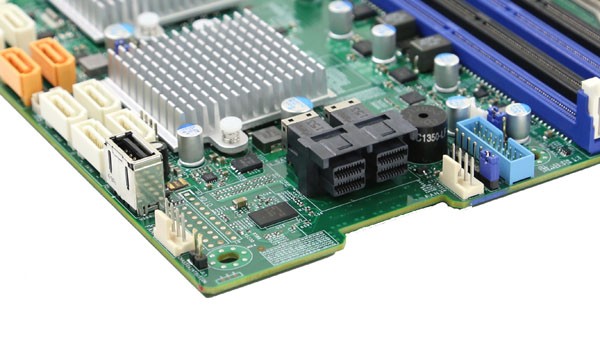
Supermicro provides both an internal USB 2.0 Type-A header as well as a front panel USB 3.0 header. There are still many workstation applications that utilize a USB hardware key so having those keys deployed inside the chassis is a preferable method. The front panel USB 3.0 header has been largely standardized across manufacturers after its introduction a few years ago.
Moving to the rear I/O panel one can see 7.1 audio outputs with an optical S/PDIF ouput. Audio is provided by the Realtek ALC888. In terms of onboard audio this is sufficient for most purposes. An audio engineer is going to use an add-in card solution and for most other applications, the ALC888 is going to be overkill. Along with the audio ports we can see four USB 3.0 ports and two USB 2.0 ports. This should be plenty for most applications and is similar to what we saw on the X10DAi.
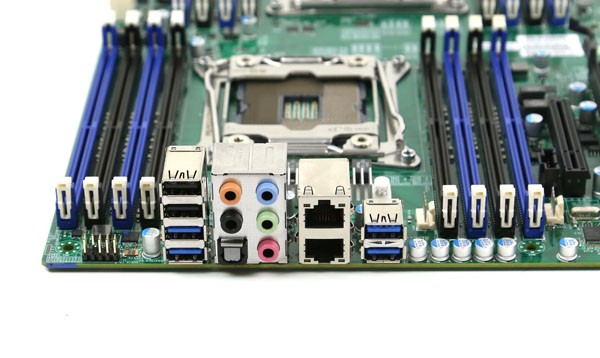
The dual gigabit Ethernet ports are powered by Intel i210 network controllers. The Intel i210 is the newer replacement for the Intel 82754L network controller and is what we see these days.
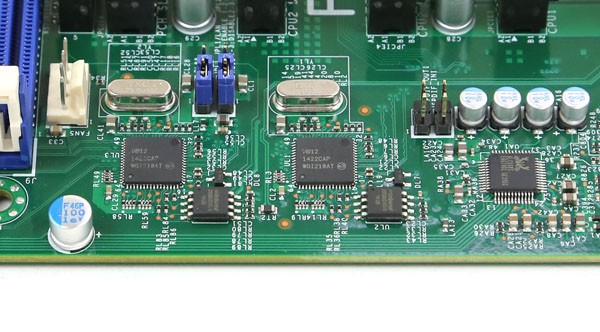
Although costlier, Supermicro’s choice of using the Intel i210 is highly preferable to using lower quality NICs. The other advantage of the Intel parts is that they are widely compatible with different operating systems and hypervisors.
Thermal Results
To capture these images we utilize our FLIR Ex series professional thermal imaging camera and turn on FLIR’s MSX enhancements so we can see components outlined clearly. We put the system under 100% CPU load for a period of 24 hours to let “heat soak” set in prior to taking the images.
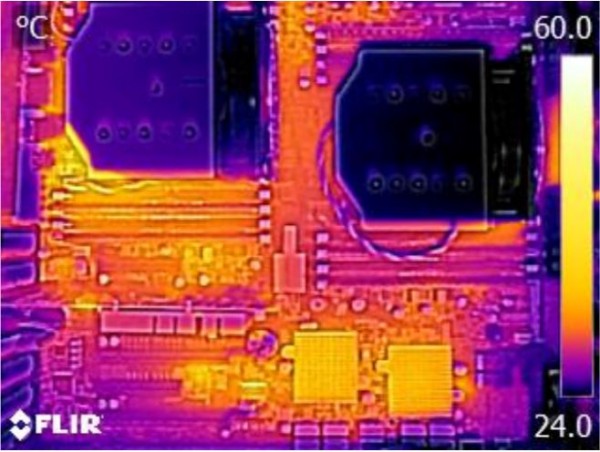
The Intel C612 platform runs very cool. One can see the impact of the in-line CPU configuration as the second heatsink (left) is slightly warmer than the first (right) due to the sequencing. Clearly both are extremely cool and at the lower end of our temperature range. In the past, SAS controllers have yielded significant hot spots on motherboards. We can see that the LSI/ Avago SAS3008 heatsink (bottom right) remains extremely cool which is important for stability.
We did use our lower power GT610 video card just to ensure a proper comparison with other workstation motherboards we have tested.
Conclusion
The Supermicro X10DAC provides a strong workstation platform for users that want extreme storage. Many other brands utilize less expensive SAS and SATA controllers but the LSI/ Avago SAS3008 controllers are stable, fast and widely compatible. With only a $100 premium over the non-SAS enabled version it does represent an excellent value for those who need additional storage ports or SAS3 storage. Suffice to say, as someone who has a need for a lot of SATA3 and SAS3 ports, this is certainly a motherboard I would use in my personal workstation without hesitation.

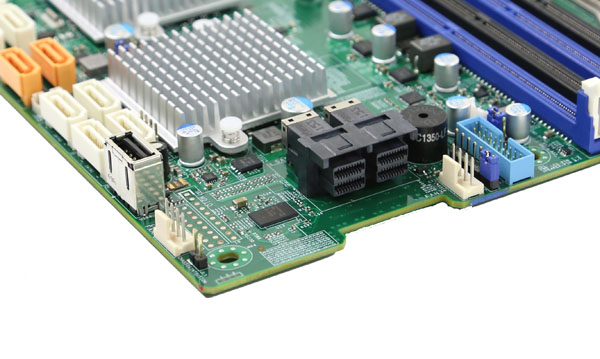


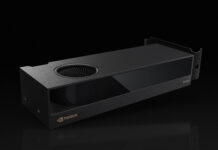
Interesting about the SATADOM, the x10 with gold sockets powers the DOM’s through the socket, no need for external power yet they fit power ports anyway. I would assume for legacy units.
http://www.supermicro.com/products/nfo/SATADOM.cfm
I count six add-in slots, not seven. Help me out to find number 7.